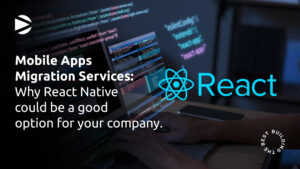What is Robotic Process Automation?
Automation continues to position itself as a must-have in business in all types of industries. According to a recent Gartner poll, more than 80 percent of companies plan to “resume or expand” automation investment, as is now a top trend in tech. Many of them are issuing automation mandates or recommendations. Hence, they create strategic and operational plans that will allow them to achieve world-class automation across their organization and support their product or services and their growth. As investment expands, boards seek to ensure that it is wisely spent because one thing is sure, it’s key to a successful future.
Low Code - No Code Automation
Low-code software allows IT and businesses to automate and digitize their business processes without writing lots of code.
Low-code automation software and low-code no-code experts help teams of all levels and experience with basic coding to build applications, workflows, or processes in just a few minutes.
This low-level programming is different than traditional back-end computer programs because it uses templates that are pre-designed for users who don’t have extensive technical knowledge of how computers operate and lets them create effectively, design pleasing results through simple drag ‘n drop interfaces rather than entering code manually into each field as before.
An example: Drag and Drop Workflow
Why Should You Look for a Low-Code Automation Platform
It’s not just the world of business that has changed. Once reserved for experts in computer science and engineering departments, software development can now be done collaboratively by low code tools accessible to almost anyone with some know-how about how computers work.
The simplicity of low-code/no-code automation is one of its most important features and one of the most appealing to businesses as well. Advanced automation aims to perform as rapidly and effectively as possible, with a minimal learning curve and excellent results.
This is good news for businesses who want to implement RPA because they can find the right talent in-house to carry out these projects. Low Code No Code also helps shorten the learning gap by making automation accessible to people of all skill levels.
LCNC it’s a powerful tool that can be used to improve your current infrastructure. It should not, however, become the sole means by which you operate; for it to work optimally with other products and platforms on an individual level, there has to be prior knowledge and guidance so it can have a seamless integration.
If you want to efficiently leverage automation for your company, don’t start from scratch. The more pre-built templates there are available in the form of tools and workflows created by others to help with faster implementation and provide a return on investment.
You have to have in mind that growth is the long-term goal, so there is no sense in investing in an automation platform if it can’t handle your company’s needs as it expands. Look for a system or a partner specialized in it so that the whole picture can be handled.
What are the benefits of RPA?
Benefits you`ll see in your business
by adding RPA
01
Cost and time saving
02
Accelerated adaptation
01
Cost and time saving
02
Accelerated adaptation
03
Greater resilience
04
Increase productivity
05
Great accuracy when delivering results
06
Employee content
Why do CIOs find appeal in automation?
Chief Information Officers (CIOs) have been looking to develop enterprise-level approaches for strategy, governance, and platform technology.
Low-code automation systems can meet the most challenging corporate requirements. Companies with the lowest tolerance for downtime and data loss, as well as high demands in terms of ongoing audits, will likely use low code applications due to the ability to save them time from having employees work manually on these apps or risk losing business opportunities because something goes wrong during operation, which would lead to losing revenue generation potentials if not stop all progress completely.
LCNC automation systems can complete the most demanding requirements; its intuitive features allow users to develop processes faster and see results sooner. If you want a competitive advantage in innovation, gaining access to these new technologies is essential.
What is UiPath?
UiPath was first in business in 2005 by Marius Circa and Daniel Dines. These two Romanian entrepreneurs set the base for what is now one of the most famous platforms of RPA worldwide.
It started in Romania and developed in Tokyo next, but now has headquarters in New York, Singapore, Bengaluru, and London.
Features, Components,
and Architecture of UiPath
UiPath offers various recording options to suit your business needs. The primary type is used for automating single tasks. In contrast, the desktop option can be applied in developing each activity’s complete selector. More advanced ones are accessible through web or Citrix recording, which allows you to record anything from pictures on a website in its virtual environment.
It has over 300 pre-built activities covering a wide range of process automation, application integration, and design. Find them in the Activities pane, which covers most design activities such as data extraction, data entry, and automation.
If you want to learn how to use UiPath, follow these great and complete tutorials on Simplilearn or Besanttechnologies.
Is RPA the same as artificial intelligence?
Why is UiPath the RPA tool for your business?
Every business needs
an intelligent system
UiPath’s automated process management software enables businesses to efficiently manage their work and schedule processes in order to meet deadlines. The intelligent system prioritizes tasks, completing them before they are due so that you can achieve more high-quality projects with less time spent on low-quality or unnecessary tasks.
Using UiPath can support businesses to adapt themselves and meet the market demands easier and more profitable. It improves their general vision and parameters that affects or influences a business’s success.
Automation experts and partners are the future
Automation experts and partners are the future
As we mentioned, there are many advantages of Robotic Process Automation for businesses. RPA can, in conclusion, be the help companies need to reach their potential and new peaks. The repetitive and time-consuming tasks are nothing but problems of the past, and it’s witnessed by C levels and teams in all areas of your company how money and time are saved, giving the real talent the freedom to focus on innovative ideas that only the human mind can put out there.
RPA can improve accuracy and consistency in data entry, assist businesses in keeping up with changing regulations and compliance requirements, and improve decision-making by providing accurate and up-to-date data. It makes your work agile but your growth process easy and organic.
It’s crucial in the world we live in today to have an RPA partner that can help you take full advantage of all your business can offer. A good match will provide a comprehensive solution that can be tailored to your specific needs.
Learn more about how UiPath can be that partner and how its partnerships have thrived with it.


